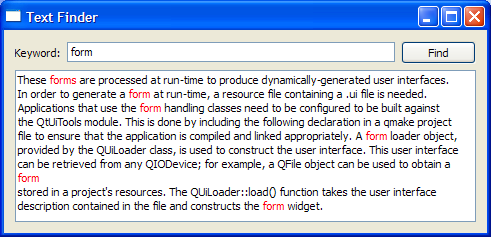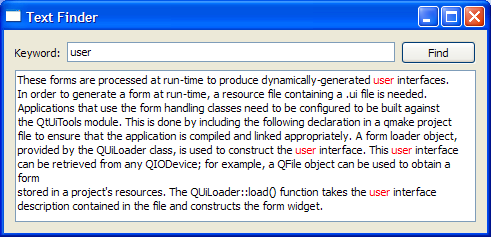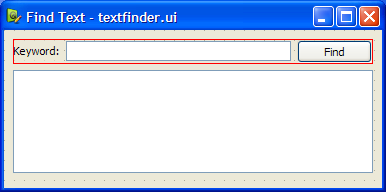Text Finder Example |
 |  |
Setting Up The Resource File
The resources required for Text Finder are:
- textfinder.ui - the user interface file created in QtDesigner
- input.txt - a text file containing some text to be displayed in the QTextEdit
textfinder.ui contains all the necessary QWidget objects for the Text Finder. A QLineEdit is used for the user input, a QTextEdit is used to display the contents of input.txt, a QLabel is used to display the text "Keyword", and a QPushButton is used for the "Find" button. The screenshot below shows the preview obtained in QtDesigner.

A textfinder.qrc file is used to store both the textfinder.ui and input.txt in the application's executable. The file contains the following code:
<!DOCTYPE RCC><RCC version="1.0">
<qresource>
<file>forms/textfinder.ui</file>
<file>forms/input.txt</file>
</qresource>
</RCC>
For more information on resource files, see The Qt Resource System.
To generate a form at run-time, the example is linked against the QtUiTools module library. This is done in the textfinder.pro file that contains the following lines:
CONFIG += uitools HEADERS = textfinder.h RESOURCES = textfinder.qrc SOURCES = textfinder.cpp main.cpp
TextFinder Class Definition
The TextFinder class is a subclass of QWidget and it hosts the QWidgets we need to access in the user interface. The QLabel in the user interface is not declared here as we do not need to access it.
class TextFinder : public QWidget
{
Q_OBJECT
public:
TextFinder(QWidget *parent = 0);
private slots:
void on_findButton_clicked();
private:
QWidget* loadUiFile();
void loadTextFile();
QPushButton *ui_findButton;
QTextEdit *ui_textEdit;
QLineEdit *ui_lineEdit;
bool isFirstTime;
};
The slot on_find_Button_clicked() is a slot named according to the Automatic Connection naming convention required by uic.
TextFinder Class Implementation
The TextFinder class's constructor calls the loadUiFile() function and then uses qFindChild() to access the user interface's QWidgets.
TextFinder::TextFinder(QWidget *parent)
: QWidget(parent)
{
QWidget *formWidget = loadUiFile();
ui_findButton = qFindChild<QPushButton*>(this, "findButton");
ui_textEdit = qFindChild<QTextEdit*>(this, "textEdit");
ui_lineEdit = qFindChild<QLineEdit*>(this, "lineEdit");
We then use QMetaObject's system to enable signal and slot connections.
QMetaObject::connectSlotsByName(this);
The loadTextFile() function is called to load input.txt into QTextEdit to displays its contents. The TextFinder's layout and window title is set and isFirstTime is set to true.
loadTextFile();
QVBoxLayout *layout = new QVBoxLayout;
layout->addWidget(formWidget);
setLayout(layout);
setWindowTitle(tr("Text Finder"));
isFirstTime = true;
}
isFirstTime is used as a flag to indicate whether the search operation has been performed more than once. This is further explained with the on_findButton_clicked() function.
The loadUiFile() function is used to load the user interface file previously created in QtDesigner. The QUiLoader class is instantiated and its load() function is used to load the form into formWidget that acts as a place holder for the user interface. The function then returns formWidget to its caller.
QWidget* TextFinder::loadUiFile()
{
QUiLoader loader;
QFile file(":/forms/textfinder.ui");
file.open(QFile::ReadOnly);
QWidget *formWidget = loader.load(&file, this);
file.close();
return formWidget;
}
As mentioned earlier, the loadTextFile() function loads input.txt into QTextEdit to display its contents. Data is read using QTextStream into a QString object, line with the QTextStream::readAll() function. The contents of line are then appended to ui_textEdit.
void TextFinder::loadTextFile()
{
QFile inputFile(":/forms/input.txt");
inputFile.open(QIODevice::ReadOnly);
QTextStream in(&inputFile);
QString line = in.readAll();
inputFile.close();
ui_textEdit->append(line);
ui_textEdit->setUndoRedoEnabled(false);
ui_textEdit->setUndoRedoEnabled(true);
}
The on_findButton_clicked() function is a slot that is connected to ui_findButton's clicked() signal. The searchString is extracted from the ui_lineEdit and the document is extracted from textEdit. In event there is an empty searchString, a QMessageBox is used, requesting the user to enter a word. Otherwise, we traverse through the words in ui_textEdit, and highlight all ocurrences of the searchString . Two QTextCursor objects are used: One to traverse through the words in line and another to keep track of the edit blocks.
void TextFinder::on_findButton_clicked()
{
QString searchString = ui_lineEdit->text();
QTextDocument *document = ui_textEdit->document();
bool found = false;
if (isFirstTime == false)
document->undo();
if (searchString == "") {
QMessageBox::information(this, tr("Empty Search Field"),
"The search field is empty. Please enter a word and click Find.");
} else {
QTextCursor highlightCursor(document);
QTextCursor cursor(document);
cursor.beginEditBlock();
QTextCharFormat plainFormat(highlightCursor.charFormat());
QTextCharFormat colorFormat = plainFormat;
colorFormat.setForeground(Qt::red);
while (!highlightCursor.isNull() && !highlightCursor.atEnd()) {
highlightCursor = document->find(searchString, highlightCursor, QTextDocument::FindWholeWords);
if (!highlightCursor.isNull()) {
found = true;
highlightCursor.movePosition(QTextCursor::WordRight,
QTextCursor::KeepAnchor);
highlightCursor.mergeCharFormat(colorFormat);
}
}
cursor.endEditBlock();
The isFirstTime flag is set to false the moment findButton is clicked. This is necessary to undo the previous text highlight before highlighting the user's next search string. Also, the found flag is used to indicate if the searchString was found within the contents of ui_textEdit. If it was not found, a QMessageBox is used to inform the user.
isFirstTime = false;
if (found == false) {
QMessageBox::information(this, tr("Word Not Found"),
"Sorry, the word cannot be found.");
}
}
}
main() Function
int main(int argc, char *argv[])
{
Q_INIT_RESOURCE(textfinder);
QApplication app(argc, argv);
TextFinder *textFinder = new TextFinder;
textFinder->show();
return app.exec();
}
The main() function initialises the textfinder.qrc resource file and instantiates as well as displays TextFinder.
See also Calculator Builder Example and World Time Clock Builder Example.
Best Of
Actualités les plus lues
- «Le projet de loi des droits du développeur» : quelles conditions doivent remplir les entreprises pour que le développeur puisse réussir ? 73
- Les développeurs détestent-ils les antivirus ? Un programmeur manifeste sa haine envers ces solutions de sécurité 27
- Une nouvelle ère d'IHM 3D pour les automobiles, un concept proposé par Digia et implémenté avec Qt 3
- Qt Creator 2.5 est sorti en beta, l'EDI supporte maintenant plus de fonctionnalités de C++11 2
- Vingt sociétés montrent leurs décodeurs basés sur Qt au IPTV World Forum, en en exploitant diverses facettes (déclaratif, Web, widgets) 0
- Thread travailleur avec Qt en utilisant les signaux et les slots, un article de Christophe Dumez traduit par Thibaut Cuvelier 1
- « Quelque chose ne va vraiment pas avec les développeurs "modernes" », un développeur à "l'ancienne" critique la multiplication des bibliothèques 102
- Pourquoi les programmeurs sont-ils moins payés que les gestionnaires de programmes ? Manquent-ils de pouvoir de négociation ? 53
- «Le projet de loi des droits du développeur» : quelles conditions doivent remplir les entreprises pour que le développeur puisse réussir ? 73
- Les développeurs détestent-ils les antivirus ? Un programmeur manifeste sa haine envers ces solutions de sécurité 27
- Qt Commercial : Digia organise un webinar gratuit le 27 mars sur la conception d'interfaces utilisateur et d'applications avec le framework 0
- Quelles nouveautés de C++11 Visual C++ doit-il rapidement intégrer ? Donnez-nous votre avis 10
- 2017 : un quinquennat pour une nouvelle version du C++ ? Possible, selon Herb Sutter 11

- Linus Torvalds : le "C++ est un langage horrible", en justifiant le choix du C pour le système de gestion de version Git 100
- Comment prendre en compte l'utilisateur dans vos applications ? Pour un développeur, « 90 % des utilisateurs sont des idiots » 229
- Quel est LE livre que tout développeur doit lire absolument ? Celui qui vous a le plus marqué et inspiré 96
- Apple cède et s'engage à payer des droits à Nokia, le conflit des brevets entre les deux firmes s'achève 158
- Nokia porte à nouveau plainte contre Apple pour violation de sept nouveaux brevets 158
- Quel est le code dont vous êtes le plus fier ? Pourquoi l'avez-vous écrit ? Et pourquoi vous a-t-il donné autant de satisfaction ? 83
- « Quelque chose ne va vraiment pas avec les développeurs "modernes" », un développeur à "l'ancienne" critique la multiplication des bibliothèques 101

Le Qt Developer Network au hasard

Combiner licence, à propos et fermer d'une autre manière
Communauté
Ressources
- 91 cours et tutoriels Qt
- F.A.Q. Qt : 200 questions et réponses
- 51 Qt Quarterly, 35 Qt Labs et 22 Qt DevNet en français
- 43 outils Qt
- 99 sources Qt et 26 binaires Qt
- 6 livres Qt et 9 critiques
- La documentation de Qt 4.7 en français : 157 classes, 70 concepts et 24 modules
- 3 certifications Qt
Liens utiles
Contact
- Vous souhaitez rejoindre la rédaction ou proposer un tutoriel, une traduction, une question... ? Postez dans le forum Contribuez ou contactez-nous par MP ou par email (voir en bas de page).
Qt dans le magazine
| Cette page est une traduction d'une page de la documentation de Qt, écrite par Nokia Corporation and/or its subsidiary(-ies). Les éventuels problèmes résultant d'une mauvaise traduction ne sont pas imputables à Nokia. | Qt 4.4 | |
| Copyright © 2012 Developpez LLC. Tous droits réservés Developpez LLC. Aucune reproduction, même partielle, ne peut être faite de ce site et de l'ensemble de son contenu : textes, documents et images sans l'autorisation expresse de Developpez LLC. Sinon, vous encourez selon la loi jusqu'à 3 ans de prison et jusqu'à 300 000 E de dommages et intérêts. Cette page est déposée à la SACD. | ||
| Vous avez déniché une erreur ? Un bug ? Une redirection cassée ? Ou tout autre problème, quel qu'il soit ? Ou bien vous désirez participer à ce projet de traduction ? N'hésitez pas à nous contacter ou par MP ! | ||
Copyright © 2000-2012 - www.developpez.com



















